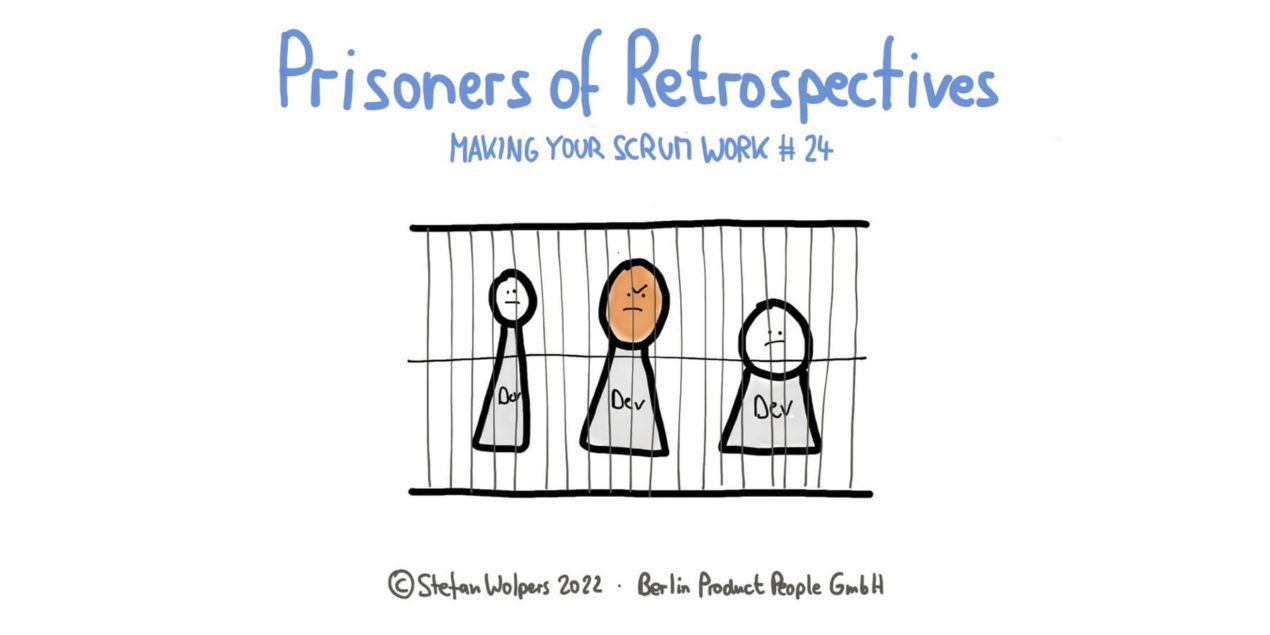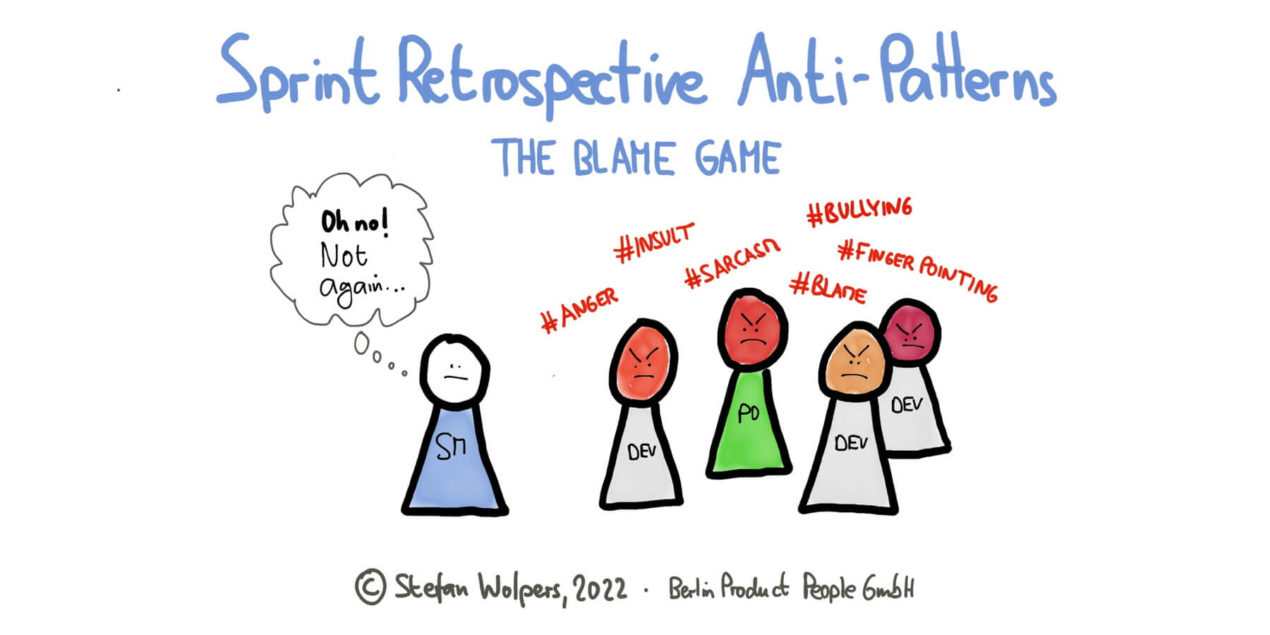TL; DR: Prisoners of Retrospectives
There are plenty of failure possibilities with Scrum. Given that Scrum is a framework with a reasonable yet short “manual,” this effect should not surprise anyone. What if, for example, not all of your Scrum team’s members feel enthusiastic about the Sprint Retrospective, the critical event when the Scrum team inspects itself? How can you help them become dedicated supporters instead? Join me and delve into how to avoid teammates feeling like prisoners of Retrospectives in less than two minutes.

🇩🇪 Zur deutschsprachigen Version des Artikels: Gefangene der Retrospektive – Making Your Scrum Work #24.
🗳 Update: Join the poll and its lively discussion on LinkedIn.
🗞 Shall I notify you about articles like this one? Awesome! You can sign up here for the ‘Food for Agile Thought’ newsletter and join 35,000-plus subscribers.
🎓 Join Stefan in one of his upcoming Professional Scrum training classes!
🖥 💯 🇬🇧 Advanced Professional Scrum Master Online Training w/ PSM II Certificate — September 6-9, 2022.

📈 🔬 Join 380-plus peers and contribute to the anonymous poll for the upcoming Free ‘Product Owner and Product Manager Salary Report 2022!’
The Sprint Retrospective According to the Scrum Guide
According to the Scrum Guide 2020, Retrospectives allow a Scrum team to inspect itself and adapt its practices:
- Page 10: The purpose of the Sprint Retrospective is to plan ways to increase quality and effectiveness.
- Page 10: The Scrum Team inspects how the last Sprint went with regards to individuals, interactions, processes, tools, and their Definition of Done.
- Page 10: [During the Sprint Retrospective,] assumptions that led [inspected elements] astray are identified and their origins explored.
- Page 10: The Scrum Team discusses what went well during the Sprint, what problems it encountered, and how those problems were (or were not) solved.
- Page 10: The Scrum Team identifies the most helpful changes to improve its effectiveness.
- Page 10: The most impactful improvements are addressed as soon as possible. They may even be added to the Sprint Backlog for the next Sprint.
- Page 10: The Sprint Retrospective concludes the Sprint.
- Page 10: [The Sprint Retrospective] is timeboxed to a maximum of three hours for a one-month Sprint. For shorter Sprints, the event is usually shorter.
Source: Scrum Guide 2020. (The aggregation is taken from the Scrum Guide 2020 Reordered.)
Cannot see the form?
Please click here.
Why Some Scrum Team Members May Feel Like Prisoners of Retrospectives
In my experience, Scrum team members may feel like prisoners of Retrospectives for several reasons, for example:
- Waste of time: The Retrospective is mechanical, ritualized, and in the end, nothing changes; is it the same procedure every time. (The team does not address critical issues, or they address the problems but then fail to follow up on previous change decisions.)
- No psychological safety: The Retrospective is an endless cycle of blame and finger-pointing. (The team wins together; the team fails together. The blame game documents both the failure of the Scrum Master as the facilitator of the Retrospective and the Scrum team’s lack of maturity and communication skills.)
- Bullying is accepted: One or two team members dominate the Retrospective. (This communication behavior is often a sign of either a weak or uninterested Scrum Master. The Retrospective needs to be a safe place where everyone–introverts included–can address issues and provide their feedback free from third-party influence. If some of the team members dominate the conversation and probably even bully or intimidate other teammates, the Retrospective will fail to provide such a safe place. This failure will result in participants dropping out of the Retrospective and render the results less valuable. It is the primary responsibility of the Scrum Master as a facilitator to ensure that everyone will be heard and has an opportunity to voice their thoughts. By the way, equally distributed speaking time is according to Google also a sign of a high-performing team. Read More: What Google Learned From Its Quest to Build the Perfect Team.)
- Line managers serve on the Scrum team: There are hierarchies among Scrum team members. For example, a junior Developer reports to a senior Developer on the same Scream team, which prevents the “subordinate” from speaking out openly. (This is a tricky situation; unfortunately, it is not uncommon, particularly in large organizations, at the beginning of an agile transformation when the people managers are not yet familiar with the details of supporting agile teams.)
The Consequences: From the continuous improvement perspective, the Retrospective is essential to a Scrum team’s future path; there is no professionalism and no self-management without constantly holding yourself accountable as a team. However, if some team members only participate in Retrospectives because they are forced to join, the whole idea of continuous improvement is undermined. Everyone on a Scrum team needs to be genuinely interested in inspecting the team’s progress to become better at what they do.
The Solution: At the team level, don’t pressure anyone to participate in a Retrospective. Instead, make it worth their time. The drive to continuously improve as a team must be fueled by intrinsic motivation, neither fear nor force. My tip: Retromat’s “Why are you here?” exercise is a good opener for a meta-retrospective on the Scrum team’s Retrospective.

Additionally, address the specific issues unearthed by the meta-retrospective with sincerity. Also, small changes often have a lot of leverage. For example, run anonymous polls among team members on Sprint achievements and issues before the Retrospective, or change the venue, rotate the facilitator role, and combine the Retrospective with food—just be creative.
Unfortunately, changes at the system level require more effort and time. Notably, this affects the line managers serving on the Scrum team challenge. Closely related to this Scrum anti-patterns is when internal employees need to approve the prolongation of contracts of freelancers.
Prisoners of Retrospectives — Conclusion
Every Scrum event is an opportunity for inspection and adaptation; next to transparency, the two pillars upon which empiricism rests. Therefore, every Scrum event is essential, and undermining it is not an option. When some team members do not participate voluntarily, you are not trying hard enough to have difficult conversations where everyone is included and has a voice—in a safe environment. Not taking the Sprint Retrospective seriously as a team to continuously improve just demonstrates that you are at a very early stage of your Scrum team’s journey. Professionals hold each other accountable; you’re an amateur at best in comparison.
Have you encountered Scrum teams where people are forced to participate in Retrospectives? Please share your learnings with us in the comments.
📖 Prisoners of Retrospectives — Related Posts
21 Sprint Retrospective Anti-Patterns Impeding Scrum Teams
Should Managers Attend Retrospectives? — Making Your Scrum Work #19
Skipping Retrospectives? — Making Your Scrum Work #17
27 Sprint Anti-Patterns Holding Back Scrum Teams
Scrum: 20 Sprint Planning Anti-Patterns
Daily Scrum Anti-Patterns: 24+2 Ways to Improve as a Scrum Team
15 Sprint Review Anti-Patterns Holding Back Scrum Teams
Download the Scrum Anti-Patterns Guide for free.
📅 Scrum Training Classes, Workshops, and Events
See all upcoming classes here.

You can book your seat for the training directly by following the corresponding links to the ticket shop. If the procurement process of your organization requires a different purchasing process, please contact Berlin Product People GmbH directly.
✋ Learn how to Avoid Teammates Feeling Like Prisoners of Retrospectives — Join the 12,000-plus Strong ‘Hands-on Agile’ Slack Community
I invite you to join the “Hands-on Agile” Slack Community and enjoy the benefits of a fast-growing, vibrant community of agile practitioners from around the world.

If you like to join all you have to do now is provide your credentials via this Google form, and I will sign you up. By the way, it’s free.

